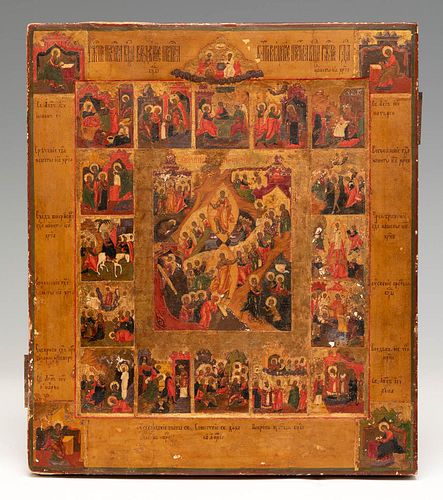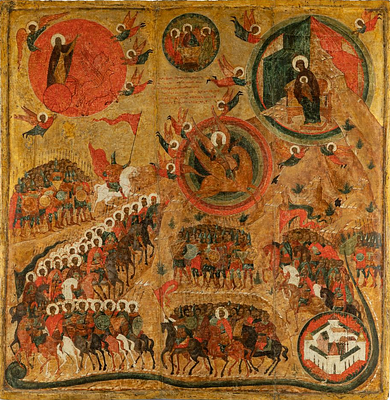Russian School of Old Believers, late 17th century. "Resurrection of Christ, Christ's Descent into Hell, and His Life in 16 hagiographic scenes". Temp
Lot 17
About Seller
Setdart Auction House
Carrer Aragó 346
Barcelona
Spain
Setdart Subastas was born in 2004 and is currently the first online art auction in Spain with solidity, prestige and reliability guaranteed by our more than 60,000 users. Setdart has a young, dynamic and enterprising team ready to successfully manage the purchase and sale of art works through custom...Read more
Estimate:
EUR€3,000 - EUR€4,000
$3,125 - $4,166.67
Absentee vs Live bid
Two ways to bid:
- Leave a max absentee bid and the platform will bid on your behalf up to your maximum bid during the live auction.
- Bid live during the auction and your bids will be submitted real-time to the auctioneer.
Bid Increments
| Price | Bid Increment |
|---|---|
| EUR€0 | EUR€10 |
| EUR€200 | EUR€25 |
| EUR€500 | EUR€50 |
| EUR€1,000 | EUR€100 |
| EUR€3,000 | EUR€200 |
| EUR€5,000 | EUR€500 |
| EUR€10,000 | EUR€1,000 |
| EUR€20,000 | EUR€2,000 |
| EUR€50,000 | EUR€5,000 |
About Auction
By Setdart Auction House
Sep 23, 2021
Set Reminder
2021-09-23 10:00:00
2021-09-23 10:00:00
America/New_York
Bidsquare
Bidsquare : RUSSIAN ICONS
https://www.bidsquare.com/auctions/setdart-auction-house/russian-icons-7431
Setdart Auction House sofia@setdart.com
Setdart Auction House sofia@setdart.com
- Lot Description
Russian School of Old Believers, late 17th century. "Resurrection of Christ, Christ's Descent into Hell, and His Life in 16 hagiographic scenes". Tempera on panel. Measurements: 35 x 30,5 cm. Descent of Christ to hell is one of the most important representations in Christian iconography. This passage has been known in Ancient Rus since the 11th century, although it became most popular in the second half of the 14th century. Iconography of this New Testament passage finally developed in the 17th century in Moscow workshops. In this period, the icon reached its maximum complexity, combining the New and Old Testament passages, and at the same time composing the scenes of the Resurrection and Christ's descent into hell into one. The icon of interest attracts the viewer's attention in a spiral, concentrating maximum attention on the central register, where, by means of a complex and dynamic composition, the resurrection and the descent into hell are narrated simultaneously. In both cases the figure of Christ in a golden mandorla is surrounded by various saints, apostles and Old Testament characters, such as Adam, who is recognised as a bearded man holding Christ's hand. This scene, in turn, is surrounded by a frame of 16 hagiographic scenes, which recount different passages from the New Testament, mostly of Marian content, although there are some scenes that recount the life of Christ. Each scene is accompanied by an inscription located on the border of the icon, where in turn, in the corners of the icon, are the four evangelists. The composition of the icon closes with a curious representation of the Trinity from the New Testament, located in the upper central register. This type of representation has different versions, in the case of the auctioned lot, it is in the form of the Father, God, the Son and the dove, the symbol of the Holy Spirit. This type of representation is typical of painters from the workshops of the Old Believers. Other features, which indicate that the icon belongs to this particular Orthodox group, are the inscriptions on the outer border of the icon, the blessing with two fingers, the eight-pointed crosses, and the name of Christ written as "ICXC", which is the abbreviation of his name in Greek.
- Shipping Info
-
In-house shipping available. Please inquire at admin@setdart.com.
-
- Buyer's Premium



 EUR
EUR CAD
CAD AUD
AUD GBP
GBP MXN
MXN HKD
HKD CNY
CNY MYR
MYR SEK
SEK SGD
SGD CHF
CHF THB
THB















